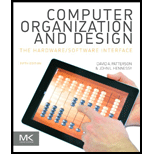
Given numbers:
Binary Multiplication:
Binary multiplication follows the following rules:
Given Information:
A, B and C are stored in 16-bit half precision format.
Explanation of Solution
Compare:
For:
Here,
Converting the above values to binary:
The exponent for
Exponent=
Here, the sign of the result is positive as all the numbers are positive and hence their product is positive. It is assumed that it has “1” guard, “1” round bit and “1” sticky bit and round to the nearest even.
The fraction of
The value of
The fraction “
Hence after rounding up to even, the value of “
For:
Here,
Converting the above values to binary:
The exponent can be represented as:
Exponent=
Here, the sign of the result is positive as all the numbers are positive and hence their product is positive. It is assumed that it has “1” guard, “1” round bit and “1” sticky bit and round to the nearest even.
The fraction of the multiplication is represented as:
Hence, the result of the product “
There is underflow as A and B are both small and their product does not fit into the 16-bit floating point format being used and hence cannot be represented.
As in 2nd case the value of
Want to see more full solutions like this?
Chapter 3 Solutions
Computer Organization and Design MIPS Edition, Fifth Edition: The Hardware/Software Interface (The Morgan Kaufmann Series in Computer Architecture and Design)
- Digital Clear line I hope the correct solution I have an exam to be the correct answer when I readarrow_forward4. Use this information to answer Question 4-8: Consider a step pn junction made of GaAs at T = 300 K. At zero bias, only 20% of the total depletion region width is in the p-side. The built-in potential o₂ = 1.20 V. Determine the acceptor density in the p-side in unit of cm³. Answers within 5% error will be considered correct. Enter answer here 5. Determine the donor density in the n-side in unit of cm³ Answers within 5% error will be considered correct. Enter answer here 6. Determine the depletion region width, z, in the n-side in unit of μm. Answers within 5% error will be considered correct. Enter answer here 7. Determine the depletion region width, xp, in the p-side in unit of μm. Answers within 5% error will be considered correct. Enter answer here 8. Determine maximum electric field in unit of V/cm. Answers within 5% error will be considered correct. Enter answer herearrow_forward1. Use this information to answer Question 1-3: Consider a step pn junction made of silicon. The p- and n-sides are doped such that Ec - EF = 0.21 eV on the n-side and EF – Ey = 0.18 eV on the p-side. The pn junction is under zero bias and kept at T = 300 K. Find the doping density in the n-side in unit of cm -3. Answers within 5% error will be considered correct. Enter answer here 2. Find the doping density in the p-side in unit of cm -3 Answers within 5% error will be considered correct. Enter answer here 3. Find the built-in potential in unit of V. Answers within 5% error will be considered correct. Enter answer herearrow_forward
- Many IT implementations are operated as projects. Project stakeholders are vital aspects of the project team. Describe a project that you have worked on and the roles of each member on the team, and then answer the following questions. If you have never been on a project, find one online and answer the following questions. Why is it important to understand the role that each member plays on the team? What organization structure was in place for the project? Was the organizational structure optimal, and if so, why was it optimal? If it was not optimal, what structure would have been the optimal structure and why?arrow_forwardThis is solely for learning purposes. Please analyze the image for me. Thank youarrow_forwardthis is for educational purposes, please anylyze the image for mearrow_forward
- Not: Solve this by karnof map Exclusively "Do not use Al tools. Solve the problem by hand on paper only and upload a photo of your handwritten solution."arrow_forwardNot: Solve this by karnof map Exclusively "Do not use Al tools. Solve the problem by hand on paper only and upload a photo of your handwritten solution."arrow_forwarddt 4-12arrow_forward
- From the following mass-spring system, obtain its transfer function and pole-zero diagram in MATLAB. Analyze how stability varies when entering values. wwwww R -0000 e(t) i(t) e(t) is the input variable, and the voltage across the capacitor is the controlled variable.arrow_forwardConduct a comprehensive study on Botnet networks, focusing on their architecture and functionality. Provide a detailed analysis of their control mechanisms via C2 (Command and Control) structures, and classify the different types of Botnets (centralized, decentralized, hybrid). Explain their primary uses in offensive contexts and discuss the evolution of detection and mitigation techniques in light of technological advancements in cybersecurity. Additional Note: Design a complete Botnet simulator using Python programming, including both the C2 server and the bot client. Demonstrate how the bots connect to the server, and how commands are sent and received between them.arrow_forwardI want to explain my work in Python botnets and it is completely working on the tkinter function with an explanation of how I can work on it with an introduction about what it is and what its benefit isarrow_forward
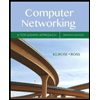 Computer Networking: A Top-Down Approach (7th Edi...Computer EngineeringISBN:9780133594140Author:James Kurose, Keith RossPublisher:PEARSON
Computer Networking: A Top-Down Approach (7th Edi...Computer EngineeringISBN:9780133594140Author:James Kurose, Keith RossPublisher:PEARSON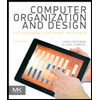 Computer Organization and Design MIPS Edition, Fi...Computer EngineeringISBN:9780124077263Author:David A. Patterson, John L. HennessyPublisher:Elsevier Science
Computer Organization and Design MIPS Edition, Fi...Computer EngineeringISBN:9780124077263Author:David A. Patterson, John L. HennessyPublisher:Elsevier Science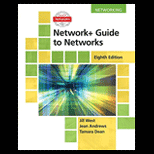 Network+ Guide to Networks (MindTap Course List)Computer EngineeringISBN:9781337569330Author:Jill West, Tamara Dean, Jean AndrewsPublisher:Cengage Learning
Network+ Guide to Networks (MindTap Course List)Computer EngineeringISBN:9781337569330Author:Jill West, Tamara Dean, Jean AndrewsPublisher:Cengage Learning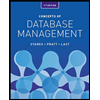 Concepts of Database ManagementComputer EngineeringISBN:9781337093422Author:Joy L. Starks, Philip J. Pratt, Mary Z. LastPublisher:Cengage Learning
Concepts of Database ManagementComputer EngineeringISBN:9781337093422Author:Joy L. Starks, Philip J. Pratt, Mary Z. LastPublisher:Cengage Learning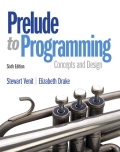 Prelude to ProgrammingComputer EngineeringISBN:9780133750423Author:VENIT, StewartPublisher:Pearson Education
Prelude to ProgrammingComputer EngineeringISBN:9780133750423Author:VENIT, StewartPublisher:Pearson Education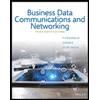 Sc Business Data Communications and Networking, T...Computer EngineeringISBN:9781119368830Author:FITZGERALDPublisher:WILEY
Sc Business Data Communications and Networking, T...Computer EngineeringISBN:9781119368830Author:FITZGERALDPublisher:WILEY





